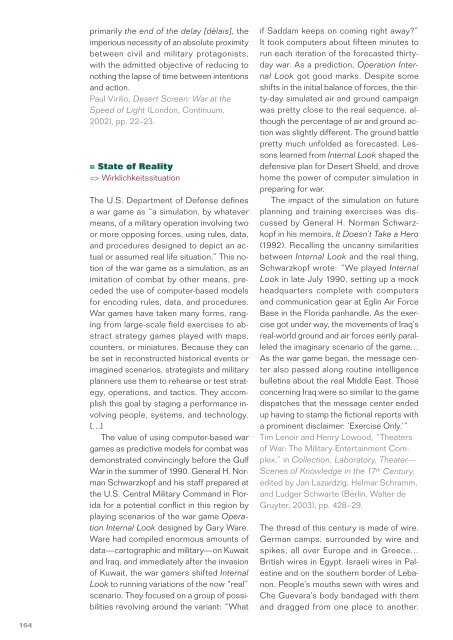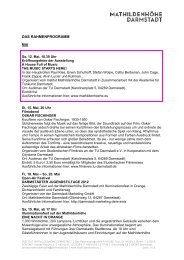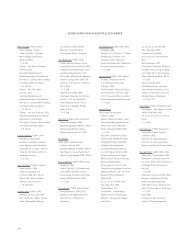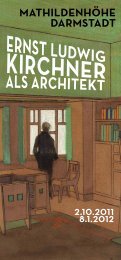Peggy Ahwesh Oliver van den Berg Wafaa Bilal ... - Mathildenhöhe
Peggy Ahwesh Oliver van den Berg Wafaa Bilal ... - Mathildenhöhe
Peggy Ahwesh Oliver van den Berg Wafaa Bilal ... - Mathildenhöhe
Sie wollen auch ein ePaper? Erhöhen Sie die Reichweite Ihrer Titel.
YUMPU macht aus Druck-PDFs automatisch weboptimierte ePaper, die Google liebt.
primarily the end of the delay [délais], the<br />
imperious necessity of an absolute proximity<br />
between civil and military protagonists,<br />
with the admitted objective of reducing to<br />
nothing the lapse of time between intentions<br />
and action.<br />
Paul Virilio, Desert Screen: War at the<br />
Speed of Light (London, Continuum,<br />
2002), pp. 22–23.<br />
= State of Reality<br />
=> Wirklichkeitssituation<br />
The U.S. Department of Defense defines<br />
a war game as “a simulation, by whatever<br />
means, of a military operation involving two<br />
or more opposing forces, using rules, data,<br />
and procedures designed to depict an actual<br />
or assumed real life situation.” This notion<br />
of the war game as a simulation, as an<br />
imitation of combat by other means, preceded<br />
the use of computer-based models<br />
for encoding rules, data, and procedures.<br />
War games have taken many forms, ranging<br />
from large-scale field exercises to abstract<br />
strategy games played with maps,<br />
counters, or miniatures. Because they can<br />
be set in reconstructed historical events or<br />
imagined scenarios, strategists and military<br />
planners use them to rehearse or test strategy,<br />
operations, and tactics. They accomplish<br />
this goal by staging a performance involving<br />
people, systems, and technology.<br />
[…]<br />
The value of using computer-based war<br />
games as predictive models for combat was<br />
demonstrated convincingly before the Gulf<br />
War in the summer of 1990. General H. Norman<br />
Schwarzkopf and his staff prepared at<br />
the U.S. Central Military Command in Florida<br />
for a potential conflict in this region by<br />
playing scenarios of the war game Operation<br />
Internal Look designed by Gary Ware.<br />
Ware had compiled enormous amounts of<br />
data—cartographic and military—on Kuwait<br />
and Iraq, and immediately after the invasion<br />
of Kuwait, the war gamers shifted Internal<br />
Look to running variations of the now “real”<br />
scenario. They focused on a group of possibilities<br />
revolving around the variant: “What<br />
if Saddam keeps on coming right away?”<br />
It took computers about fifteen minutes to<br />
run each iteration of the forecasted thirtyday<br />
war. As a prediction, Operation Internal<br />
Look got good marks. Despite some<br />
shifts in the initial balance of forces, the thirty-day<br />
simulated air and ground campaign<br />
was pretty close to the real sequence, although<br />
the percentage of air and ground action<br />
was slightly different. The ground battle<br />
pretty much unfolded as forecasted. Lessons<br />
learned from Internal Look shaped the<br />
defensive plan for Desert Shield, and drove<br />
home the power of computer simulation in<br />
preparing for war.<br />
The impact of the simulation on future<br />
planning and training exercises was discussed<br />
by General H. Norman Schwarz-<br />
kopf in his memoirs, It Doesn’t Take a Hero<br />
(1992). Recalling the uncanny similarities<br />
between Internal Look and the real thing,<br />
Schwarzkopf wrote: “We played Internal<br />
Look in late July 1990, setting up a mock<br />
headquarters complete with computers<br />
and communication gear at Eglin Air Force<br />
Base in the Florida panhandle. As the exercise<br />
got under way, the movements of Iraq’s<br />
real-world ground and air forces eerily paralleled<br />
the imaginary scenario of the game…<br />
As the war game began, the message center<br />
also passed along routine intelligence<br />
bulletins about the real Middle East. Those<br />
concerning Iraq were so similar to the game<br />
dispatches that the message center ended<br />
up having to stamp the fictional reports with<br />
a prominent disclaimer: ‘Exercise Only.’”<br />
Tim Lenoir and Henry Lowood, “Theaters<br />
of War: The Military-Entertainment Complex,”<br />
in Collection, Laboratory, Theater—<br />
Scenes of Knowledge in the 17 th Century,<br />
edited by Jan Lazardzig, Helmar Schramm,<br />
and Ludger Schwarte (Berlin, Walter de<br />
Gruyter, 2003), pp. 428–29.<br />
The thread of this century is made of wire.<br />
German camps, surrounded by wire and<br />
spikes, all over Europe and in Greece…<br />
British wires in Egypt. Israeli wires in Palestine<br />
and on the southern border of Lebanon.<br />
People’s mouths sewn with wires and<br />
Che Guevara’s body bandaged with them<br />
and dragged from one place to another.<br />
A Viet Cong hanged not by rope but by iron.<br />
All the little electric wires which criss-cross<br />
my brain, attaching in an imperfect way one<br />
thought to another, my hunger to my exile,<br />
and my body to this place. Each one of us<br />
is a dog attached by steel threads to a purpose,<br />
waiting for lightning to strike.<br />
Etel Adnan, In the Heart of the Heart of<br />
Another Country (San Francisco, City<br />
Light Books, 2005), pp. 9–10.<br />
= Steyerl, Hito<br />
After the Crash / Before the Crash<br />
2009, 2 Videos, Farbe, 6 Min., 14 Min.<br />
Courtesy of the artist<br />
Während die Eingangssequenz mit einer<br />
Filmmontage abstürzender Flugzeuge beginnt,<br />
die am Bo<strong>den</strong> zerschellen, sehen wir<br />
in After the Crash nur die »Geister« von<br />
Flugzeugen, die über <strong>den</strong> kleinen Wüstenflughafen<br />
von Mojave, Kalifornien, verstreut<br />
sind. Zwischen diesen bei<strong>den</strong> Punkten suggerieren<br />
mehrdeutige Fragmente von Hito<br />
Steyerls Interview mit dem Flughafenbesitzer<br />
und Ex-TWA-Piloten Mike Potter die<br />
Geschichte dieser Metallreste. Das Interview<br />
kreist um wirtschaftlichen Absturz und<br />
finanziellen Gewinn, Aluminiumschrott und<br />
die Zusammenfassung der Handlung von<br />
Hollywoodfilmen. All dies wird mit verschie<strong>den</strong>en<br />
filmischen Verweisen illustriert, die<br />
auf einem kleinen tragbaren DVD-Player zu<br />
sehen sind, der unbeholfen im Wüstensand<br />
steht. Jedes neue Interviewteil und jeder<br />
neue DVD-Clip verdrängt <strong>den</strong> nächsten und<br />
lässt ihn in einem anderen Licht erscheinen.<br />
Von dem Interview geht die Gangart abrupt<br />
zu edukativem Unterhaltungs-Scratchvideo<br />
über, und die Erzählung preist die Stabilität<br />
und Langlebigkeit von Aluminium als<br />
recyclebarem Produkt. Auch hier wieder<br />
wiederholt sich die Prämisse, die Form<br />
erstehe in etwas Neuem wieder auf, in<br />
derselben Eingangsmontage der unmittelbar<br />
drohen<strong>den</strong> Zerstörung: der permanent<br />
wiederholte Sturz von der Gestaltung zur<br />
Neugestaltung.<br />
Before the Crash beginnt mit Sergej Tretjakows<br />
[Essay] »Die Biographie des Dings«<br />
von 1929 und führt die Hauptfigur, die Boeing<br />
707-700 4X-JYI, ein. Die Geschichte der<br />
4X-JYI geht weiter mit dem Zusammenbruch<br />
der Wall Street 1929, Howard Hughes’ Kauf<br />
der Fluglinie TWA, der Umwandlung in eine<br />
israelische Militärmaschine und schließlich<br />
dem Verkauf der Maschine in die USA 1978<br />
als Verschrottungsobjekt. Nachdem sie auf<br />
<strong>den</strong> Mojave-Flughafen gebracht wurde, wird<br />
die 4X-JYI mit neuen Emblemen versehen<br />
und repariert, bevor sie für das Finale des<br />
Films Speed 1994 in die Luft gesprengt<br />
wird und die Reste nach China verkauft<br />
wer<strong>den</strong>, um im dortigen florieren<strong>den</strong> DVD-<br />
Markt zum Einsatz zu kommen. In einem<br />
alternativen Ende der Filmbiografie kommt<br />
ein anderes Modell desselben Flugzeugs,<br />
4X-JYD, bei einer israelischen Militäraktion<br />
zum Einsatz, bei der ein von palästinensischen<br />
Terroristen entführtes Flugzeug der<br />
Air France 1976 auf dem Flughafen von<br />
Entebbe befreit wer<strong>den</strong> soll. Der Entführungsversuch<br />
wird in drei unterschiedliche<br />
Spielfilme aufgeteilt, während die 4X-JYD<br />
in der Folge als Maschine des israelischen<br />
Staatspräsi<strong>den</strong>ten und dann als Kino in einem<br />
Luftwaffenmuseum in Hatzarim benutzt<br />
wird. Bei jeder dieser Neufassungen steht<br />
dem Verständnis des Objekts 4X-JYI ein<br />
Überangebot an Darstellungen im Weg, das<br />
zu keiner klaren Festlegung, sondern zu einem<br />
Mangel an Festlegungen führt. Die disjunktive<br />
Perspektive der grünen Leinwand-<br />
wüste hinter dem seine Erzählung vortragen<strong>den</strong><br />
Historiker wird offenkundig, und der<br />
Rahmen seines sachlichen Vortrags fällt mit<br />
dem Skript eines Schauspielers zusammen.<br />
Das, als das man etwas kennt, wird hinfällig<br />
und neu verortet: Der Historiker wird zum<br />
Schauspieler, das Flugzeug zur DVD.<br />
Gil Leung, »After before now: Notes on In<br />
Free Fall«, Collective, Edinburgh, August,<br />
2010: online unter: http://www.picture-this.<br />
org.uk/library/essays1/2010/after-beforenow-notes-on-in-free-fall,<br />
Zugriff vom<br />
10. Dezember 2010 (Übersetzung:<br />
Nikolaus G. Schneider).<br />
164 165









